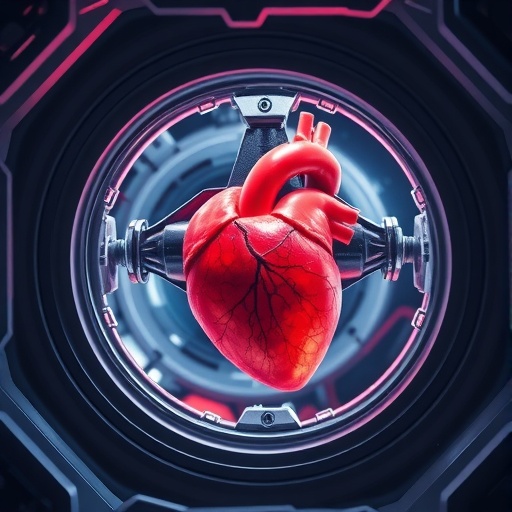The exploration of space has yielded countless scientific revelations and technological advancements, but it has also introduced complex challenges that require innovative solutions. Among these challenges, the preservation of human health—particularly cardiovascular health—during extended periods in microgravity has emerged as a critical area of research. Dr. A. Silburn, a researcher specializing in aerospace medicine, has conducted an in-depth study addressing this pivotal issue. His recent work focuses on understanding the intricate effects of low Earth orbit’s microgravity environment on the cardiovascular system and developing strategies to counteract these detrimental effects.
As astronauts venture into the vast unknown, they encounter a unique set of physiological responses that can jeopardize their health. Microgravity creates an environment where the body experiences fluid redistribution, affecting blood volume and circulation. This can lead to orthostatic intolerance upon return to Earth, where individuals may face significant challenges, such as fainting or dizziness. Silburn’s research indicates that the human cardiovascular system is not adapted for prolonged exposure to microgravity, emphasizing the urgency of understanding and mitigating these risks.
One intriguing aspect of Silburn’s findings is the substantial role of muscle and skeletal systems in cardiovascular function. When astronauts are subjected to the weightlessness of space, there is a marked reduction in muscle mass and skeletal density. These changes can perturb the heart’s ability to pump effectively, potentially leading to compromised cardiovascular performance. The research outlines how targeted exercise regimens can help counteract muscle atrophy and maintain cardiovascular integrity, showcasing the importance of physical activity even in the absence of gravity.
Significantly, Silburn notes the importance of tailored exercise protocols that astronauts can utilize aboard the International Space Station (ISS). These protocols are designed to stimulate blood flow and maintain cardiovascular fitness levels. Utilizing advanced technologies and specialized equipment, astronauts engage in resistance and aerobic exercises, which play a critical role in promoting heart health during their missions. This innovative approach not only addresses the immediate health concerns posed by microgravity but also provides a framework for understanding exercise’s broader implications in maintaining cardiovascular health here on Earth.
The study also delves into the physiological adaptations that occur in response to microgravity. For instance, the body undergoes a reduction in plasma volume, which can lead to decreased stroke volume—the amount of blood pumped by the heart with each beat. Silburn’s observations raise significant questions about the long-term effects of these adaptations, particularly concerning astronauts who embark on missions lasting several months or longer. The implications extend beyond space exploration, prompting considerations for those who may be bedridden or immobile for extended periods.
Silburn’s research is fortified by an analysis of physiological data gathered from astronauts during and after their missions. This data offers invaluable insights into the cardiovascular changes that occur in response to microgravity, highlighting the variability among individuals. In particular, factors such as age, gender, pre-flight fitness levels, and even genetic predispositions play a role in how each astronaut’s cardiovascular system responds to the challenges of spaceflight. This variability underscores the necessity of individualized approaches to health monitoring and prevention strategies for future missions.
In addition to exercising, Silburn emphasizes the role of nutritional strategies in preserving cardiovascular health while in space. The research discusses how a well-balanced diet, rich in essential nutrients, can support cardiovascular function and promote recovery after the physical stresses of space travel. Research into the optimal dietary needs of astronauts is ongoing, with findings that suggest a high intake of potassium, omega-3 fatty acids, and antioxidants can specifically benefit cardiovascular health.
Another fascinating element of Silburn’s findings is the potential for countermeasures beyond exercise and nutrition. Researchers are investigating pharmaceutical interventions that could enhance cardiovascular responses during long-duration missions. These developments provide promising avenues for protecting astronauts’ health and enhancing their performance in space. Such innovations could lead to the use of medications that stabilize fluid balance or enhance vascular function, which could be pivotal for former and future space travelers.
Silburn raises critical ethical considerations as well. The safety and well-being of astronauts are paramount, and this necessitates a careful balance between the exploration of space and the preservation of human health. As missions become longer and ventures to distant planets become more feasible, the establishment of robust health protocols will be crucial. This study reinforces the concept that the pursuit of knowledge should never compromise human health, providing a roadmap for responsible and ethical exploration.
Moreover, the implications of Silburn’s research cascade beyond the realms of space medicine. The findings and recommendations outlined in this study bear relevance for medical professionals and researchers working with populations experiencing prolonged immobility on Earth. Understanding the cardiovascular adaptations to microgravity may offer significant insights into treating patients on Earth who are confined to their beds or living a sedentary lifestyle.
In conclusion, as humanity continues to reach for the stars, the necessity of preserving cardiovascular health in microgravity becomes increasingly clear. Dr. A. Silburn’s extensive research underscores the interplay between exercise, nutrition, and pharmaceutical innovations in addressing these challenges. The dedication to ensure the health of astronauts while venturing into space reflects a commitment to safeguarding human values even in the pursuit of scientific achievement. As we stand on the cusp of interplanetary exploration, understanding how to combat the adverse effects of microgravity will play a crucial role in shaping the future of space travel.
With ongoing advancements in research and technology, the collective efforts of scientists like Silburn offer hope for healthier journeys into the cosmos. By prioritizing cardiovascular health, we can pave the way for a new era of exploration where the limits of human endurance are continually pushed while maintaining the essential well-being required for such extraordinary endeavors.
Subject of Research: Preservation of cardiovascular health in microgravity
Article Title: Counteracting microgravity: preserving cardiovascular health in low earth orbit
Article References:
Silburn, A. Counteracting microgravity: preserving cardiovascular health in low earth orbit.
Military Med Res 12, 53 (2025). https://doi.org/10.1186/s40779-025-00642-y
Image Credits: AI Generated
DOI: https://doi.org/10.1186/s40779-025-00642-y
Keywords: Cardiovascular health, microgravity, space exploration, astronaut health, exercise protocols, nutrition, pharmaceutical interventions.




